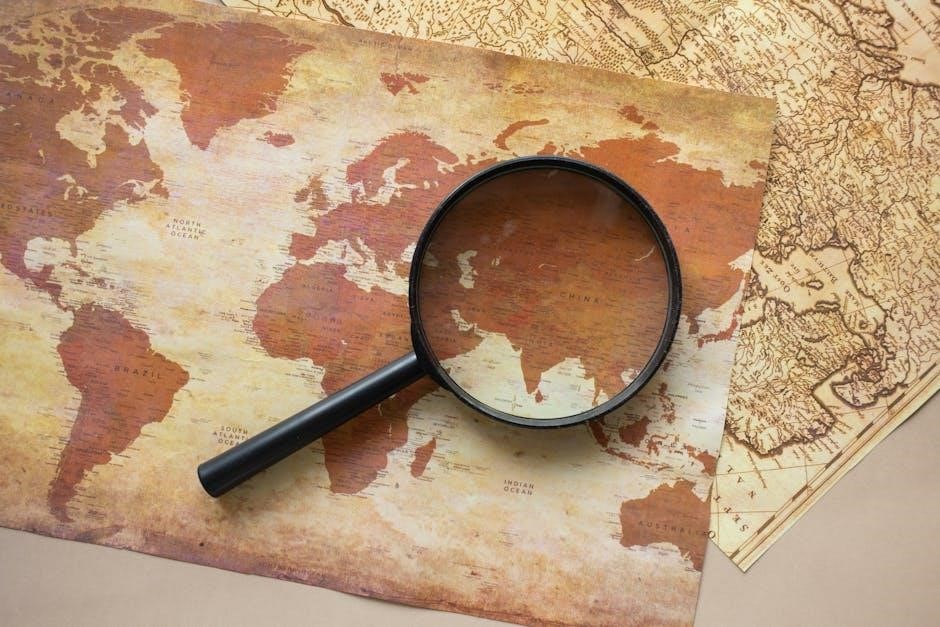This section explores global conflicts from 1900 to the present, focusing on World Wars, the Cold War, and modern conflicts․ It highlights causes, key events, and their lasting impacts on global politics and society․

Global warfare refers to large-scale conflicts involving multiple nations or regions, often with significant geopolitical, economic, and social consequences․ From the early 20th century to the present, global warfare has evolved, driven by nationalism, imperialism, and ideological differences․ The two World Wars and the Cold War reshaped the global landscape, while modern conflicts, such as terrorism and proxy wars, continue to impact international relations․ Technological advancements, such as nuclear weapons and cyber warfare, have intensified the potential for destruction․ Understanding global warfare requires examining its historical roots, key events, and the roles of diplomacy and military strategy․ This section provides a foundation for analyzing the complex dynamics of global conflict, emphasizing how historical events inform contemporary challenges․ By studying global warfare, students gain insights into the interconnectedness of nations and the enduring quest for peace and security in an increasingly interconnected world․ This introduction sets the stage for exploring specific causes, events, and impacts of global conflicts in subsequent sections․
Causes of World War I
The outbreak of World War I was the result of a combination of factors, including political alliances, imperialism, militarism, and nationalism․ The complex system of alliances, such as the Triple Entente and the Triple Alliance, created a situation in which a small conflict could quickly escalate into a larger war․ Imperialism fueled competition for colonies and resources, while militarism, the buildup of military forces, heightened tensions among European powers․ Nationalism, particularly in the Balkans, led to ethnic tensions and the desire for independence, further destabilizing the region․ The assassination of Archduke Franz Ferdinand of Austria-Hungary by a Serbian nationalist in 1914 served as the immediate trigger, but the underlying causes made the war almost inevitable․ These factors intertwined to create a volatile environment in which diplomacy failed, leading to the outbreak of one of the deadliest conflicts in history․ Understanding these causes is essential to grasping the complexities of global warfare in the early 20th century․
Key Events of World War I
World War I was marked by several pivotal events that shaped its progression and outcome․ The assassination of Archduke Franz Ferdinand in 1914 triggered the war’s outbreak, leading to widespread conflict across Europe․ Trench warfare dominated the Western Front, characterized by prolonged stalemates and massive casualties․ The Battle of the Somme in 1916 and the Battle of Verdun in 1916 were particularly devastating, showcasing the horrors of modern warfare; The introduction of new technologies, such as machine guns, tanks, and chemical weapons, further intensified the brutality․ In 1917, the United States entered the war after Germany resumed unrestricted submarine warfare and sank American ships․ Russia’s withdrawal from the war in 1917, following the Bolshevik Revolution, allowed Germany to focus on the Western Front․ The Armistice of November 11, 1918, finally ended the fighting, leading to the Treaty of Versailles․ These events highlight the war’s complexity and its profound impact on global history․
Treaty of Versailles and Its Impact
The Treaty of Versailles, signed on June 28, 1919, officially ended World War I․ It imposed harsh penalties on Germany, including significant territorial losses and heavy reparations․ The War Guilt Clause, which blamed Germany for the war, fueled widespread resentment among the German population․ The treaty’s terms severely weakened the German economy, leading to hyperinflation and economic instability in the 1920s․ This economic hardship contributed to the rise of Adolf Hitler and the Nazi Party, setting the stage for World War II․ The treaty also redrew the map of Europe, creating new nations and altering borders, which led to ongoing tensions․ Many historians argue that the treaty’s punitive measures created a sense of injustice in Germany, undermining the possibility of long-term peace․ The Treaty of Versailles remains a critical topic in understanding the interwar period and its role in shaping global conflicts․ Its legacy highlights the challenges of achieving a lasting peace after devastating warfare․
The Interwar Period
The interwar period, spanning from 1918 to 1939, was marked by political instability, economic turmoil, and rising tensions that ultimately led to World War II․ Following World War I, Europe faced significant challenges, including the collapse of empires and the establishment of new nations․ The global economy struggled with the Great Depression, leading to high unemployment and widespread poverty․ In Germany, hyperinflation and economic hardship fueled resentment over the Treaty of Versailles, creating fertile ground for extremist ideologies․
This era saw the rise of fascist regimes, with leaders like Adolf Hitler in Germany, Benito Mussolini in Italy, and militaristic expansion in Japan․ These nations pursued aggressive foreign policies, challenging the post-war order․ The League of Nations, established to maintain peace, proved ineffective in addressing these threats․ Additionally, the policy of appeasement practiced by Britain and France allowed Germany to annex territories, such as the Sudetenland, without resistance, further emboldening Hitler․
The interwar period also witnessed technological advancements and rearmament, as nations prepared for potential conflict․ By the late 1930s, the fragile peace had eroded, setting the stage for the outbreak of World War II․ This period remains a critical study in understanding the failures of diplomacy and the origins of global conflict․
Causes of World War II
The outbreak of World War II was the result of a combination of factors, including the aftermath of World War I, aggressive nationalist policies, and the failure of the League of Nations․ The Treaty of Versailles imposed harsh penalties on Germany, leading to economic hardship and widespread resentment․ This created fertile ground for Adolf Hitler and the Nazi Party to rise to power, promising to restore German greatness and challenge the treaty’s terms․
Meanwhile, fascist regimes in Italy and Japan pursued expansionist policies, seeking to establish empires and secure resources․ Germany remilitarized the Rhineland, annexed Austria, and invaded Czechoslovakia, while Italy conquered Ethiopia, and Japan expanded into China․ The policy of appeasement, particularly Britain and France’s reluctance to confront Nazi aggression, allowed Hitler to pursue his ambitions unchecked․
Economic instability, including the Great Depression, further destabilized the global order, fostering extremism and militarism․ The formation of the Axis alliance between Germany, Italy, and Japan solidified their shared goals of territorial expansion and dominance․ These factors culminated in Germany’s invasion of Poland in 1939, prompting Britain and France to declare war, marking the start of World War II․
Key Events of World War II
World War II was marked by several pivotal events that shaped its course and outcome․ The invasion of Poland in 1939 by Nazi Germany triggered the war’s start, prompting Britain and France to declare war․ The Battle of Britain in 1940 was a decisive air campaign where the Royal Air Force repelled the German Luftwaffe, preventing a Nazi invasion of Britain․
In 1941, Germany launched Operation Barbarossa, a massive invasion of the Soviet Union, leading to prolonged and bloody fighting on the Eastern Front․ The same year, Japan attacked Pearl Harbor, drawing the United States into the war․ The D-Day invasion of Normandy in 1944 marked a turning point, as Allied forces gained a foothold in Nazi-occupied Europe․
The Battle of Stalingrad in 1942-1943 was a major Soviet victory, halting the German advance․ The dropping of atomic bombs on Hiroshima and Nagasaki in 1945 by the United States led to Japan’s surrender, ending the war․ These events, along with the Holocaust, defined the conflict’s scale and impact․
The Holocaust
The Holocaust was a systematic genocide carried out by Nazi Germany during World War II, targeting Jews, Romani people, disabled individuals, political dissidents, and others deemed undesirable by the regime․ Approximately six million Jews were murdered, along with millions of others, in concentration camps such as Auschwitz, Buchenwald, and Treblinka․
The Nazis utilized industrial-scale methods, including gas chambers, to carry out mass exterminations․ Forced labor camps and ghettos were also established to exploit and brutalize victims․ The Holocaust remains one of the darkest chapters in human history, highlighting the dangers of racism, xenophobia, and totalitarianism․
Key events include Kristallnacht in 1938, marking the escalation of anti-Semitic violence, and the liberation of concentration camps by Allied forces in 1944-1945, revealing the full extent of Nazi atrocities․ The Holocaust serves as a stark reminder of the importance of promoting tolerance, human rights, and international cooperation to prevent such horrors from recurring․
End of World War II
The end of World War II was marked by the defeat of the Axis powers and the emergence of the United States and the Soviet Union as superpowers․ In Europe, the war concluded on May 8, 1945, with Germany’s unconditional surrender, known as V-E Day․ This followed the Allied liberation of concentration camps, revealing the horrors of the Holocaust, and the Soviet capture of Berlin․
In the Pacific, the war ended on August 15, 1945, after the United States dropped atomic bombs on Hiroshima and Nagasaki, leading to Japan’s surrender․ The formal surrender ceremony took place on September 2, 1945, aboard the USS Missouri․
The Yalta Conference in February 1945 played a crucial role in shaping the post-war world, as Allied leaders discussed territorial divisions and the formation of the United Nations․ The end of WWII also set the stage for the Cold War, as tensions between the U․S․ and the Soviet Union began to rise․ The war’s conclusion brought relief but also ushered in a new era of geopolitical instability and nuclear deterrence․
Origins of the Cold War
The Cold War originated in the aftermath of World War II, driven by ideological, political, and economic tensions between the United States and the Soviet Union․ The two superpowers had fundamentally different visions for the post-war world․ The U․S․ advocated for capitalism and democracy, while the Soviet Union promoted communism and a centralized state system․
Tensions began during the Yalta Conference in 1945, where disagreements arose over territorial divisions and the reconstruction of Europe․ The Soviet Union’s establishment of communist governments in Eastern Europe, known as the Eastern Bloc, deepened U․S․ concerns․ In response, the U․S․ adopted the Truman Doctrine in 1947, committing to contain Soviet expansion and support democracies globally․
The Marshall Plan, launched in 1948, further strained relations by rebuilding Western Europe economically, which the Soviets perceived as a threat․ The division of Germany into East and West symbolized the growing divide․ By 1949, the Cold War was firmly established, with the formation of NATO and the Warsaw Pact solidifying the geopolitical split․ These events marked the beginning of a decades-long rivalry that would shape global politics․
Key Events of the Cold War
The Cold War was marked by significant events that heightened tensions and shaped global geopolitics․ One of the earliest key events was the Berlin Blockade (1948-1949), where the Soviet Union blocked Western Allies’ access to Berlin, prompting the massive Berlin Airlift․
In 1950, the Korean War broke out, pitting North Korean and Chinese communist forces against South Korea and U․N․ troops led by the U․S․ The war ended in 1953 with the signing of the Armistice Agreement, leaving Korea divided․

The Cuban Missile Crisis (1962) brought the world to the brink of nuclear war as the U․S․ and Soviet Union confronted each other over missile sites in Cuba․ A last-minute agreement averted disaster․

The Space Race became a symbol of technological rivalry, with the Soviet Union launching Sputnik in 1957 and the U․S․ landing astronauts on the Moon in 1969․
The 1961 construction of the Berlin Wall physically divided East and West Berlin, symbolizing the Iron Curtain․ Later, the 1970s détente period saw efforts to ease tensions, including arms control agreements․
The Cold War effectively ended with the collapse of the Soviet Union in 1991, marking the triumph of Western democracy and capitalism․ These events defined the era’s tension and rivalry․
The Arms Race and Space Race
The Arms Race and Space Race were defining features of the Cold War, driven by the rivalry between the United States and the Soviet Union․ The Arms Race involved rapid advancements in military technology, particularly nuclear weapons․ Both superpowers developed massive arsenals, including intercontinental ballistic missiles (ICBMs) and hydrogen bombs, to deter each other through the doctrine of mutually assured destruction (MAD)․ This competition escalated defense spending, placing immense economic strain on both nations․
The Space Race emerged as a symbolic extension of this rivalry․ The Soviet Union’s launch of Sputnik in 1957 marked the beginning, shocking the U․S․ into intensifying its space program․ The Americans responded with the establishment of NASA in 1958 and achieved a historic milestone with the Apollo 11 Moon landing in 1969․ The Space Race not only showcased technological prowess but also served as propaganda to demonstrate ideological superiority․ The collapse of the Soviet Union in 1991 marked the end of the Cold War and a significant shift in global geopolitics․ Several factors contributed to its demise․ Economic stagnation was a major issue, as the Soviet economy struggled under the weight of centralized planning and massive military spending․ The Arms Race with the United States drained resources, while the Space Race showcased technological achievements but diverted funds from domestic needs․ Additionally, political repression and ethnic tensions within the Soviet Union created widespread discontent․ The rise of glasnost and perestroika under Mikhail Gorbachev aimed to reform the system but inadvertently exposed its weaknesses․ The fall of the Berlin Wall in 1989 symbolized the decline of Soviet influence, as Eastern European nations broke free from communist rule․ The final collapse came when hardline communist leaders attempted a coup against Gorbachev in 1991, further destabilizing the government․ On December 26, 1991, the Soviet Union was officially dissolved, leading to the independence of its 15 republics․ This event reshaped the global balance of power and ended the Cold War․
Modern global conflicts are shaped by a mix of political, economic, and social factors․ Regional disputes, such as those in the Middle East and Eastern Europe, continue to fuel tensions․ The Russia-Ukraine conflict, for instance, has had far-reaching consequences, including economic sanctions and a massive refugee crisis․ Terrorism remains a persistent threat, with groups like ISIS and Al-Qaeda employing asymmetric warfare tactics․ Cyberattacks have also emerged as a critical tool in modern conflict, targeting critical infrastructure and governments worldwide․ Economic competition between major powers, such as the U․S․ and China, has intensified, particularly in areas like trade and technology․ This rivalry often spills over into diplomatic and military spheres, raising concerns about potential escalation․ Finally, climate change is increasingly recognized as a driver of conflict, as resource scarcity and environmental instability exacerbate existing tensions․ Addressing these challenges requires international cooperation and innovative solutions to ensure global stability and security․ The technological advancements of the 20th and 21st centuries have profoundly transformed the nature of warfare․ Drones and autonomous weapons systems now play central roles in modern conflicts, allowing for precision strikes with reduced risk to human soldiers․ Cyber warfare has emerged as a critical domain, with nations employing cyberattacks to disrupt critical infrastructure, steal data, and influence political outcomes․ The development of artificial intelligence (AI) and machine learning has further revolutionized military tactics, enabling predictive analytics and enhanced decision-making․ Satellites and global positioning systems (GPS) have become indispensable for navigation, communication, and surveillance․ However, these advancements also raise ethical concerns․ The use of AI in warfare blurs the lines of accountability, while the proliferation of cyberattacks poses risks to global stability․ Additionally, the cost of advanced technologies creates disparities between nations, potentially escalating tensions․ As technology continues to evolve, its role in warfare will remain a pivotal issue, shaping both the strategies and the ethical dilemmas of future conflicts․ Wars and global conflicts have profound economic and social consequences that resonate long after the fighting ends․ Economically, wars disrupt trade, destroy infrastructure, and divert resources from essential public services to military spending․ The cost of modern warfare, including advanced weaponry and technology, places a heavy burden on national economies․ For instance, the 2008 financial crisis and the COVID-19 pandemic exacerbated economic instability, leading to widespread job losses and home foreclosures․ Socially, warfare often leads to the displacement of populations, creating refugee crises and straining international aid systems․ The psychological toll on soldiers and civilians, including post-traumatic stress disorder (PTSD), further strains societal resources․ Additionally, conflicts can deepen societal divisions, fostering mistrust and extremism․ Governments have historically used economic tools, such as tariffs and sanctions, to exert pressure during conflicts․ For example, higher tariffs on China were implemented to protect domestic industries and promote economic recovery․ However, such measures can also lead to trade wars and further economic instability․ The intersection of economic and social impacts underscores the need for sustainable recovery and conflict resolution to prevent long-term global instability․
Both races underscored the Cold War’s competitive nature, driving innovation but also heightening global tensions․ These events remain pivotal in understanding the era’s geopolitical dynamics and their lasting impact on modern technology․
Collapse of the Soviet Union
Modern Global Conflicts

Technological Impact on Warfare
Economic and Social Impact
